Courses


 Compare
Compare
Mill's Methods of Experimental Inquiry are a set of principles formulated by philosopher John Stuart Mill to identify and establish causal relationships in scientific experiments. These methods help determine the cause-and-effect relationship between events or phenomena by observing and analyzing their patterns. Here’s a short description of Mill's methods, which are particularly useful in experimental inquiry: 1. Method of Agreement Description: This method suggests that if two or more instances of a phenomenon have only one common factor, then that common factor is likely the cause of the effect. Example: If multiple people experience a headache after eating a specific food, the food might be the cause of the headache. 2. Method of Difference Description: This method involves comparing two situations that are similar except for one factor. If the effect occurs in one case and not the other, the difference is likely the cause. Example: If one person feels fine after eating food and another gets sick, the factor causing the sickness may lie in the food or the specific conditions of the second person. 3. Method of Concomitant Variation Description: According to this method, if a change in one factor is accompanied by a change in another, the two factors may be causally related. Example: A rise in temperature may lead to an increase in the rate of evaporation, showing a connection between temperature and evaporation rate. 4. Method of Residues Description: This method involves subtracting known causes from a phenomenon to identify the remaining unexplained factor, which may be the cause of the effect. Example: If the behavior of an animal can be explained by hunger and pain, any unexplained behavior might be caused by another factor, such as curiosity. 5. Method of Analogy Description: This method draws conclusions about causality based on the similarity of known causes and effects in similar situations. Example: If a disease in humans is caused by a particular virus, a similar disease in animals may be hypothesized to be caused by the same virus. মিল-এর পরীক্ষামূলক অনুসন্ধানের পদ্ধতিগুলি দার্শনিক জন স্টুয়ার্ট মিল দ্বারা বৈজ্ঞানিক পরীক্ষায় কার্যকারণ সম্পর্ক সনাক্ত ও প্রতিষ্ঠার জন্য প্রণীত নীতিগুলির একটি সেট। এই পদ্ধতিগুলি ঘটনা বা ঘটনাগুলির নিদর্শন পর্যবেক্ষণ ও বিশ্লেষণের মাধ্যমে তাদের মধ্যে কারণ ও প্রভাবের সম্পর্ক নির্ধারণ করতে সহায়তা করে। এখানে মিলের পদ্ধতিগুলির একটি সংক্ষিপ্ত বিবরণ দেওয়া হল, যা পরীক্ষামূলক অনুসন্ধানে বিশেষভাবে কার্যকরঃ 1টি। চুক্তির পদ্ধতি বর্ণনাঃ এই পদ্ধতিটি পরামর্শ দেয় যে যদি কোনও ঘটনার দুই বা ততোধিক দৃষ্টান্তের মধ্যে কেবল একটি সাধারণ ফ্যাক্টর থাকে, তবে সেই সাধারণ ফ্যাক্টরটি সম্ভবত প্রভাবের কারণ। উদাহরণস্বরূপঃ যদি একাধিক ব্যক্তি একটি নির্দিষ্ট খাবার খাওয়ার পরে মাথাব্যথা অনুভব করে, তবে সেই খাবারটি মাথাব্যথার কারণ হতে পারে। 2. পার্থক্যের পদ্ধতি বর্ণনাঃ এই পদ্ধতিতে একটি ফ্যাক্টর ছাড়া দুটি পরিস্থিতির তুলনা করা হয় যা একই রকম। যদি প্রভাবটি একটি ক্ষেত্রে ঘটে এবং অন্যটি না হয়, তবে পার্থক্যটি সম্ভবত কারণ। উদাহরণস্বরূপঃ যদি একজন ব্যক্তি খাবার খাওয়ার পরে ভাল বোধ করেন এবং অন্যজন অসুস্থ হয়ে পড়েন, তবে অসুস্থতার কারণ হতে পারে খাদ্য বা দ্বিতীয় ব্যক্তির নির্দিষ্ট অবস্থার মধ্যে। 3. সঙ্গতিপূর্ণ পরিবর্তনের পদ্ধতি বর্ণনাঃ এই পদ্ধতি অনুসারে, যদি একটি ফ্যাক্টরের পরিবর্তনের সাথে অন্য একটি ফ্যাক্টরের পরিবর্তন হয়, তবে দুটি ফ্যাক্টর কারণগতভাবে সম্পর্কিত হতে পারে। উদাহরণস্বরূপঃ তাপমাত্রা বৃদ্ধি বাষ্পীভবনের হার বৃদ্ধি করতে পারে, যা তাপমাত্রা এবং বাষ্পীভবনের হারের মধ্যে একটি সংযোগ দেখায়। 4. অবশিষ্টাংশের পদ্ধতি বর্ণনাঃ এই পদ্ধতিতে একটি ঘটনা থেকে পরিচিত কারণগুলি বাদ দিয়ে অবশিষ্ট অব্যক্ত ফ্যাক্টর সনাক্ত করা হয়, যা প্রভাবের কারণ হতে পারে। উদাহরণস্বরূপঃ যদি কোনও প্রাণীর আচরণ ক্ষুধা এবং ব্যথা দ্বারা ব্যাখ্যা করা যায়, তবে যে কোনও অব্যক্ত আচরণ কৌতূহলের মতো অন্য কোনও কারণের কারণে হতে পারে। 5. সাদৃশ্যের পদ্ধতি বর্ণনাঃ এই পদ্ধতিটি অনুরূপ পরিস্থিতিতে পরিচিত কারণ এবং প্রভাবগুলির সাদৃশ্যের উপর ভিত্তি করে কার্যকারিতা সম্পর্কে সিদ্ধান্ত নেয়। উদাহরণস্বরূপঃ যদি মানুষের মধ্যে কোনও রোগ কোনও নির্দিষ্ট ভাইরাস দ্বারা সৃষ্ট হয়, তবে প্রাণীদের মধ্যে একই ধরনের রোগ একই ভাইরাস দ্বারা সৃষ্ট বলে অনুমান করা যেতে পারে।
0 Lessons
Hours
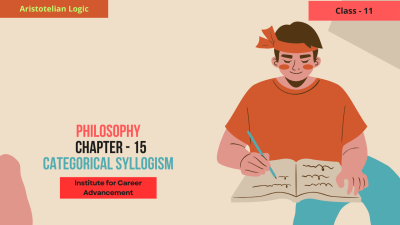
 Compare
Compare
A categorical syllogism is a type of deductive argument consisting of three categorical propositions: Two premises: These provide the supporting evidence. One conclusion: This is the statement that logically follows from the premises. Key Features: Categorical Propositions: These are statements that relate two categories (or classes) of things. They typically use terms like "all," "no," and "some." Examples: All humans are mortal. (Universal Affirmative) No dogs are cats. (Universal Negative) Some students are athletes. (Particular Affirmative) Some students are not athletes. (Particular Negative) Three Terms: Major Term: The predicate of the conclusion. Minor Term: The subject of the conclusion. Middle Term: A term that appears in both premises but not in the conclusion. It acts as a bridge between the other two terms. Example: Premise 1: All mammals are warm-blooded. (Major Premise) Premise 2: All dogs are mammals. (Minor Premise) Conclusion: All dogs are warm-blooded. Why Study Categorical Syllogisms? Developing Logical Reasoning: Studying categorical syllogisms helps develop critical thinking and logical reasoning skills. Analyzing Arguments: It provides a framework for analyzing and evaluating the validity of arguments. Understanding Deductive Reasoning: It illustrates the principles of deductive reasoning, where conclusions are logically derived from premises. Foundation for Advanced Logic: It lays the foundation for understanding more complex forms of logical reasoning. By studying categorical syllogisms, students learn to identify the components of an argument, evaluate its validity, and improve their ability to reason logically and critically. একটি শ্রেণীগত সিলেজিজম হল তিন ধরনের শ্রেণীগত প্রস্তাবনা নিয়ে গঠিত এক ধরনের অবরোহী যুক্তিঃ দুটি প্রেক্ষাপটঃ এগুলি সমর্থনকারী প্রমাণ সরবরাহ করে। একটি উপসংহারঃ এই বিবৃতিটি যৌক্তিকভাবে প্রাঙ্গণ থেকে অনুসরণ করা হয়। মূল বৈশিষ্ট্যঃ শ্রেণীগত প্রস্তাবঃ এগুলি এমন বিবৃতি যা জিনিসগুলির দুটি বিভাগ (বা শ্রেণী) সম্পর্কিত। তারা সাধারণত "সব", "না" এবং "কিছু" এর মতো শব্দ ব্যবহার করে। উদাহরণগুলোঃ সব মানুষই মরণশীল। (সার্বজনীন সমর্থন) কোনও কুকুর বিড়াল নয়। (সর্বজনীন নেতিবাচক) কিছু শিক্ষার্থী ক্রীড়াবিদ। (বিশেষ সমর্থন) কিছু ছাত্র ক্রীড়াবিদ নয়। (বিশেষ নেতিবাচক) তিনটি শর্তঃ মেজর টার্মঃ উপসংহারের পূর্বাভাস। মাইনর টার্মঃ উপসংহারের বিষয়। মধ্য মেয়াদিঃ এমন একটি শব্দ যা উভয় প্রাঙ্গণে উপস্থিত হয় কিন্তু উপসংহারে নয়। এটি অন্য দুটি শব্দের মধ্যে একটি সেতু হিসাবে কাজ করে। উদাহরণঃ প্রস্তাবনা 1: সমস্ত স্তন্যপায়ী প্রাণী উষ্ণ রক্তের হয়। (প্রধান প্রাঙ্গণ) প্রস্তাবনা 2ঃ সব কুকুরই স্তন্যপায়ী। (ছোট প্রাঙ্গণ) উপসংহারঃ সমস্ত কুকুর উষ্ণ রক্তের হয়। কেন শ্রেণীগত সিলেজিজম অধ্যয়ন করবেন? যৌক্তিক যুক্তির বিকাশঃ শ্রেণীবদ্ধ শব্দাংশ অধ্যয়ন সমালোচনামূলক চিন্তাভাবনা এবং যৌক্তিক যুক্তি দক্ষতা বিকাশে সহায়তা করে। আর্গুমেন্ট বিশ্লেষণঃ এটি আর্গুমেন্টের বৈধতা বিশ্লেষণ ও মূল্যায়নের জন্য একটি কাঠামো প্রদান করে। ডিডাক্টিভ রিজনিং বোঝাঃ এটি ডিডাক্টিভ রিজনিং-এর নীতিগুলি চিত্রিত করে, যেখানে সিদ্ধান্তগুলি যৌক্তিকভাবে প্রাঙ্গণ থেকে উদ্ভূত হয়। উন্নত যুক্তির ভিত্তিঃ এটি যৌক্তিক যুক্তির আরও জটিল রূপগুলি বোঝার ভিত্তি স্থাপন করে। শ্রেণীবদ্ধ সিলেজিজম অধ্যয়ন করে, শিক্ষার্থীরা একটি যুক্তির উপাদানগুলি সনাক্ত করতে, এর বৈধতা মূল্যায়ন করতে এবং যৌক্তিক ও সমালোচনামূলকভাবে যুক্তি করার ক্ষমতা উন্নত করতে শেখে।
0 Lessons
Hours
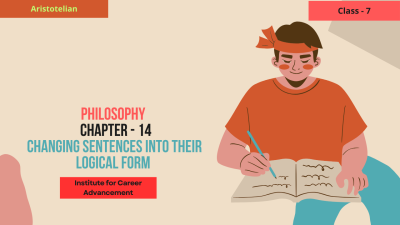
 Compare
Compare
In logic, we often translate natural language sentences into a more formal, symbolic representation. This process helps to: Clarify meaning: By breaking down sentences into their logical components, we can better understand their underlying structure and meaning. Identify assumptions: Translating sentences into logical form can help us identify hidden assumptions and potential ambiguities. Analyze arguments: Logical forms make it easier to analyze the validity and soundness of arguments. Key Steps: Identify Propositions: Determine the key propositions within the sentence. A proposition is a declarative statement that can be either true or false. Identify Logical Connectives: Determine the logical relationships between the propositions. Common connectives include: Conjunction: "and" (represented by ∧) Disjunction: "or" (represented by ∨) Negation: "not" (represented by ¬) Conditional: "if...then" (represented by →) Biconditional: "if and only if" (represented by ↔) Translate into Symbolic Form: Represent the propositions with letters (e.g., p, q, r) and use the appropriate symbols for the logical connectives to form the logical expression. Example: Sentence: If it rains, then the game will be canceled. Propositions: p: It rains. q: The game will be canceled. Logical Form: p → q Why is this Important? Developing Analytical Skills: This process helps develop analytical and critical thinking skills, as it requires careful attention to the meaning and structure of language. Foundation for Advanced Logic: Translating sentences into logical form is a fundamental skill for studying more advanced topics in logic, such as propositional logic, predicate logic, and modal logic. Real-World Applications: These skills have applications in various fields, including computer science, artificial intelligence, and legal reasoning. By learning to translate sentences into their logical form, students can gain a deeper understanding of the structure of language and the principles of logical reasoning. যুক্তিতে, আমরা প্রায়শই প্রাকৃতিক ভাষার বাক্যগুলিকে আরও আনুষ্ঠানিক, প্রতীকী উপস্থাপনায় অনুবাদ করি। এই প্রক্রিয়াটি সাহায্য করেঃ অর্থ স্পষ্ট করুনঃ বাক্যগুলিকে তাদের যৌক্তিক উপাদানগুলিতে বিভক্ত করে, আমরা তাদের অন্তর্নিহিত কাঠামো এবং অর্থ আরও ভালভাবে বুঝতে পারি। অনুমানগুলি চিহ্নিত করুনঃ বাক্যগুলিকে যৌক্তিক আকারে অনুবাদ করা আমাদের লুকানো অনুমান এবং সম্ভাব্য অস্পষ্টতা সনাক্ত করতে সহায়তা করতে পারে। আর্গুমেন্ট বিশ্লেষণ করুনঃ লজিক্যাল ফর্মগুলি আর্গুমেন্টের বৈধতা এবং দৃঢ়তা বিশ্লেষণ করা সহজ করে তোলে। মূল পদক্ষেপঃ প্রস্তাবগুলি চিহ্নিত করুনঃ বাক্যের মধ্যে মূল প্রস্তাবগুলি নির্ধারণ করুন। প্রস্তাব হল একটি ঘোষণামূলক বিবৃতি যা সত্য বা মিথ্যা হতে পারে। যৌক্তিক সংযোগগুলি চিহ্নিত করুনঃ প্রস্তাবগুলির মধ্যে যৌক্তিক সম্পর্ক নির্ধারণ করুন। সাধারণ সংযোগগুলির মধ্যে রয়েছেঃ সংযোগঃ "এবং" (দ্বারা প্রতিনিধিত্ব করা হয়) বিচ্ছিন্নকরণঃ "বা" (দ্বারা প্রতিনিধিত্ব করা হয়) নেতিবাচকঃ "না" (দ্বারা প্রতিনিধিত্ব করা হয়) শর্তসাপেক্ষঃ "if... then" (দ্বারা প্রতিনিধিত্ব করা →) দ্বি-শর্তঃ "যদি এবং শুধুমাত্র যদি" (দ্বারা প্রতিনিধিত্ব করা হয়) প্রতীকী আকারে অনুবাদ করুনঃ অক্ষর (e.g., p, q, r) সহ প্রস্তাবগুলি উপস্থাপন করুন এবং যৌক্তিক অভিব্যক্তি গঠনের জন্য যৌক্তিক সংযোগগুলির জন্য উপযুক্ত প্রতীকগুলি ব্যবহার করুন। উদাহরণঃ বাক্যঃ বৃষ্টি হলে খেলা বাতিল হয়ে যাবে। প্রস্তাবনাঃ উঃ বৃষ্টি হচ্ছে। প্রশ্নঃ খেলাটি বাতিল করা হবে। লজিক্যাল ফর্মঃ p → q কেন এটি গুরুত্বপূর্ণ? বিশ্লেষণাত্মক দক্ষতার বিকাশঃ এই প্রক্রিয়াটি বিশ্লেষণাত্মক এবং সমালোচনামূলক চিন্তাভাবনার দক্ষতা বিকাশে সহায়তা করে, কারণ এর জন্য ভাষার অর্থ এবং কাঠামোর প্রতি যত্নশীল মনোযোগ প্রয়োজন। উন্নত যুক্তির ভিত্তিঃ যুক্তিতে আরও উন্নত বিষয়, যেমন প্রস্তাবনা যুক্তিবিজ্ঞান, প্রেডিকেট লজিক এবং মোডাল লজিক অধ্যয়নের জন্য বাক্যগুলিকে যৌক্তিক আকারে অনুবাদ করা একটি মৌলিক দক্ষতা। রিয়েল-ওয়ার্ল্ড অ্যাপ্লিকেশনঃ এই দক্ষতাগুলির কম্পিউটার বিজ্ঞান, কৃত্রিম বুদ্ধিমত্তা এবং আইনি যুক্তি সহ বিভিন্ন ক্ষেত্রে প্রয়োগ রয়েছে। বাক্যগুলিকে তাদের যৌক্তিক আকারে অনুবাদ করতে শেখার মাধ্যমে, শিক্ষার্থীরা ভাষার কাঠামো এবং যৌক্তিক যুক্তির নীতিগুলি সম্পর্কে গভীর ধারণা অর্জন করতে পারে।
0 Lessons
Hours

 Compare
Compare
In logic, the Square of Opposition is a diagram that illustrates the relationships between four types of categorical propositions: A (Universal Affirmative): All S are P. (e.g., All dogs are mammals.) E (Universal Negative): No S are P. (e.g., No cats are dogs.) I (Particular Affirmative): Some S are P. (e.g., Some students are athletes.) O (Particular Negative): Some S are not P. (e.g., Some students are not athletes.) Relationships: Contradiction: A and O are contradictories. They cannot both be true and cannot both be false. If one is true, the other must be false, and vice versa. Contrariety: A and E are contraries. They cannot both be true, but they can both be false. Subcontrariety: I and O are subcontraries. They can both be true, but they cannot both be false. Subalternation: A implies I, and E implies O. If a universal proposition is true, its corresponding particular proposition must also be true. Existential Import: Existential Import refers to whether a proposition implies the existence of the subject term. Traditional View: Traditionally, particular propositions (I and O) were assumed to have existential import. This means that "Some S are P" implies that there exist at least some S. Modern View: In modern logic, existential import is often not assumed for universal propositions (A and E). This means that "All S are P" does not necessarily imply that any S exist. যুক্তিতে, বিরোধী স্কোয়ার হল একটি চিত্র যা চার ধরনের শ্রেণীগত প্রস্তাবের মধ্যে সম্পর্ককে চিত্রিত করেঃ A (সর্বজনীন ইতিবাচক) সমস্ত S হল P। (e.g., সব কুকুর স্তন্যপায়ী হয়। ই (সর্বজনীন নেতিবাচক) সংখ্যা এস হল পি। (e.g., কোন বিড়াল কুকুর নয়। I (সুনির্দিষ্ট ইতিবাচক) কিছু S হল P। (e.g., কিছু ছাত্র ক্রীড়াবিদ হয়। ও (বিশেষ নেতিবাচক) কিছু এস পি নয়। (e.g., কিছু ছাত্র ক্রীড়াবিদ নয়। সম্পর্কঃ দ্বন্দ্বঃ এ এবং ও পরস্পরবিরোধী। দুটোই সত্য হতে পারে না এবং দুটোই মিথ্যা হতে পারে না। যদি একটি সত্য হয়, অন্যটি অবশ্যই মিথ্যা হতে হবে, এবং তদ্বিপরীত। বৈপরীত্যঃ A এবং E পরস্পরবিরোধী। দুটোই সত্য হতে পারে না, তবে দুটোই মিথ্যা হতে পারে। সাবকনট্রারিটিঃ I এবং O হল সাবকনট্রারি। দুটোই সত্য হতে পারে, কিন্তু দুটোই মিথ্যা হতে পারে না। সাবালটার্নেশনঃ A মানে I, এবং E মানে O। যদি একটি সার্বজনীন প্রস্তাব সত্য হয়, তবে তার সংশ্লিষ্ট নির্দিষ্ট প্রস্তাবটিও অবশ্যই সত্য হতে হবে। অস্তিত্বগত গুরুত্বঃ অস্তিত্বগত গুরুত্ব বোঝায় যে কোনও প্রস্তাব বিষয় শব্দের অস্তিত্বকে বোঝায় কিনা। ঐতিহ্যগত দৃষ্টিভঙ্গিঃ ঐতিহ্যগতভাবে, নির্দিষ্ট প্রস্তাবগুলির (I এবং O) অস্তিত্বগত গুরুত্ব রয়েছে বলে ধরে নেওয়া হয়েছিল। এর অর্থ হল "কিছু এস হল পি" বোঝায় যে কমপক্ষে কিছু এস রয়েছে। আধুনিক দৃষ্টিভঙ্গিঃ আধুনিক যুক্তিতে, সর্বজনীন প্রস্তাবের (এ এবং ই) জন্য অস্তিত্বগত গুরুত্ব প্রায়শই ধরে নেওয়া হয় না। এর অর্থ হল "সমস্ত এস হল পি" এর অর্থ এই নয় যে কোনও এস-এর অস্তিত্ব রয়েছে।
0 Lessons
Hours
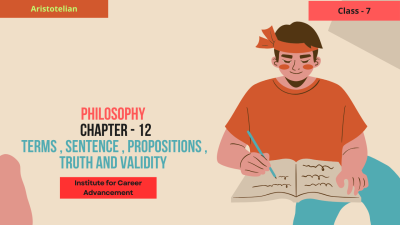
 Compare
Compare
In the realm of logic, understanding the following concepts is fundamental: Terms: These are the building blocks of propositions. They can be single words or phrases that represent a concept, object, or property. For example, "cat," "justice," "the tallest building," "greater than." Sentence: A sentence is a grammatical unit that expresses a complete thought. It can be declarative (making a statement), interrogative (asking a question), imperative (giving a command), or exclamatory (expressing strong emotion). Not all sentences are propositions. Propositions: A proposition is a declarative sentence that is either true or false, but not both. It expresses a complete thought and can be evaluated for its truth value. Examples: "The Earth revolves around the Sun." (True) "2 + 2 = 5" (False) "All dogs are mammals." (True) Truth: The truth value of a proposition indicates whether it accurately reflects reality. A true proposition corresponds to reality, while a false proposition does not. Validity: In the context of deductive arguments, validity refers to the logical structure of the argument. An argument is valid if its conclusion follows logically from its premises. In other words, if the premises are true, the conclusion must also be true. Note: A valid argument can have false premises and a false conclusion. Key Points: Truth and Validity are distinct concepts: A valid argument can have false premises, and a sound argument must have true premises and a valid structure. Propositions are the foundation of logical reasoning: They provide the basic units of analysis for evaluating arguments and drawing conclusions. By understanding these core concepts, students in Class 11 can begin to develop critical thinking skills, analyze arguments effectively, and improve their ability to reason logically. যুক্তির ক্ষেত্রে, নিম্নলিখিত ধারণাগুলি বোঝা মৌলিকঃ শর্তাবলীঃ এগুলি প্রস্তাবের ভিত্তি। এগুলি একক শব্দ বা বাক্যাংশ হতে পারে যা একটি ধারণা, বস্তু বা বৈশিষ্ট্যের প্রতিনিধিত্ব করে। উদাহরণস্বরূপ, "বিড়াল", "ন্যায়বিচার", "সবচেয়ে উঁচু বিল্ডিং", "এর চেয়ে বড়"। বাক্যঃ একটি বাক্য একটি ব্যাকরণগত একক যা একটি সম্পূর্ণ চিন্তা প্রকাশ করে। এটি ঘোষণাত্মক (একটি বিবৃতি দেওয়া) জিজ্ঞাসাবাদমূলক (একটি প্রশ্ন জিজ্ঞাসা করা) আবশ্যক (একটি আদেশ দেওয়া) বা বিস্ময়কর (দৃঢ় আবেগ প্রকাশ) হতে পারে। সব বাক্য প্রস্তাবনা নয়। প্রস্তাবনাঃ একটি প্রস্তাব একটি ঘোষণামূলক বাক্য যা সত্য বা মিথ্যা, তবে উভয়ই নয়। এটি একটি সম্পূর্ণ চিন্তাভাবনা প্রকাশ করে এবং এর সত্য মূল্যের জন্য মূল্যায়ন করা যেতে পারে। উদাহরণগুলোঃ "পৃথিবী সূর্যের চারদিকে ঘোরে।" (সত্য) "2 + 2 = 5" (মিথ্যা) "সব কুকুরই স্তন্যপায়ী।" (সত্য) সত্যঃ একটি প্রস্তাবের সত্য মান নির্দেশ করে যে এটি সঠিকভাবে বাস্তবতাকে প্রতিফলিত করে কিনা। একটি সত্য প্রস্তাবনা বাস্তবতার সাথে মিলে যায়, যখন একটি মিথ্যা প্রস্তাবনা হয় না। বৈধতাঃ অনুমানমূলক আর্গুমেন্টের প্রসঙ্গে, বৈধতা আর্গুমেন্টের যৌক্তিক কাঠামোকে বোঝায়। একটি যুক্তি বৈধ যদি তার উপসংহার তার প্রাঙ্গণ থেকে যৌক্তিকভাবে অনুসরণ করে। অন্য কথায়, যদি ভিত্তিটি সত্য হয়, তবে উপসংহারটিও অবশ্যই সত্য হতে হবে। দ্রষ্টব্যঃ একটি বৈধ যুক্তির ভিত্তি মিথ্যা এবং উপসংহার মিথ্যা হতে পারে। মূল বিষয়গুলোঃ সত্য এবং বৈধতা হল স্বতন্ত্র ধারণাঃ একটি বৈধ যুক্তির মিথ্যা ভিত্তি থাকতে পারে এবং একটি সঠিক যুক্তির অবশ্যই সত্য ভিত্তি এবং একটি বৈধ কাঠামো থাকতে হবে। প্রস্তাবগুলি যৌক্তিক যুক্তির ভিত্তিঃ এগুলি যুক্তি মূল্যায়ন এবং সিদ্ধান্ত গ্রহণের জন্য বিশ্লেষণের মৌলিক একক সরবরাহ করে। এই মূল ধারণাগুলি বোঝার মাধ্যমে, একাদশ শ্রেণির শিক্ষার্থীরা সমালোচনামূলক চিন্তাভাবনা দক্ষতা বিকাশ করতে, কার্যকরভাবে যুক্তি বিশ্লেষণ করতে এবং যৌক্তিকভাবে যুক্তি করার ক্ষমতা উন্নত করতে পারে।
0 Lessons
Hours
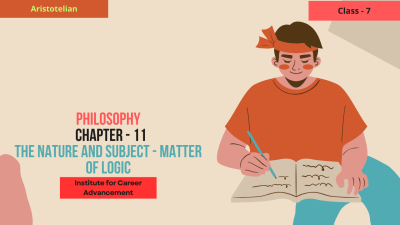
 Compare
Compare
Logic is the study of reasoning and argumentation. It's concerned with how we think, how we construct arguments, and how we can determine whether those arguments are valid or sound. Key Aspects: Formal vs. Informal Logic: Formal Logic: Deals with the structure and form of arguments, focusing on the validity of inferences based on their logical form, regardless of the content. Informal Logic: Concerned with the content and context of arguments, evaluating them for their strength, relevance, and persuasiveness in everyday language. Core Concepts: Propositions: Statements that can be either true or false. Arguments: A set of propositions where one or more (premises) are intended to support another (conclusion). Validity: A deductive argument is valid if its conclusion necessarily follows from its premises. Soundness: A deductive argument is sound if it is both valid and its premises are true. Laws of Thought: Law of Identity: A thing is identical to itself (A is A). Law of Non-Contradiction: A thing cannot be both A and not-A at the same time and in the same respect. Law of Excluded Middle: A thing must either be A or not-A; there is no third option. যুক্তি হল যুক্তি এবং যুক্তির অধ্যয়ন। আমরা কীভাবে চিন্তা করি, কীভাবে যুক্তি তৈরি করি এবং সেই যুক্তিগুলি বৈধ বা সঠিক কিনা তা আমরা কীভাবে নির্ধারণ করতে পারি তার সাথে এটি সম্পর্কিত। মূল দিকগুলিঃ আনুষ্ঠানিক বনাম। অনানুষ্ঠানিক যুক্তিঃ আনুষ্ঠানিক যুক্তিঃ বিষয়বস্তু নির্বিশেষে, তাদের যৌক্তিক রূপের উপর ভিত্তি করে অনুমানের বৈধতার উপর দৃষ্টি নিবদ্ধ করে আর্গুমেন্টের কাঠামো এবং ফর্মের সাথে ডিল করে। অনানুষ্ঠানিক যুক্তিঃ তর্কের বিষয়বস্তু এবং প্রসঙ্গের সাথে সম্পর্কিত, দৈনন্দিন ভাষায় তাদের শক্তি, প্রাসঙ্গিকতা এবং প্ররোচনার জন্য তাদের মূল্যায়ন করা। মূল ধারণাগুলিঃ প্রস্তাবনাঃ এমন বিবৃতি যা সত্য বা মিথ্যা হতে পারে। যুক্তিঃ প্রস্তাবের একটি সেট যেখানে এক বা একাধিক (প্রাঙ্গণ) অন্য (উপসংহার) সমর্থন করার উদ্দেশ্যে করা হয় বৈধতাঃ একটি অবরোহী যুক্তি বৈধ যদি তার উপসংহার অবশ্যই তার প্রাঙ্গণ থেকে অনুসরণ করে। দৃঢ়তা (সাউন্ডনেস): একটি অনুমানমূলক যুক্তি যদি বৈধ হয় এবং এর ভিত্তি উভয়ই সত্য হয়। চিন্তার নিয়মঃ পরিচয়ের আইনঃ একটি জিনিস নিজের সাথে অভিন্ন (এ হল এ) অ-দ্বন্দ্বের আইনঃ একটি জিনিস একই সময়ে এবং একই ক্ষেত্রে এ এবং না-এ উভয়ই হতে পারে না। বাদ দেওয়া মধ্যের আইনঃ একটি জিনিস অবশ্যই A বা না-A হতে হবে; কোনও তৃতীয় বিকল্প নেই।
0 Lessons
Hours
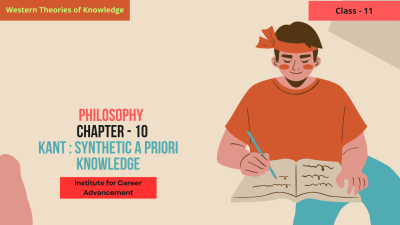
 Compare
Compare
Immanuel Kant, a prominent figure in Enlightenment philosophy, introduced the concept of synthetic a priori knowledge. This concept is central to his critical philosophy and has had a profound impact on Western thought. Understanding the Terms: Synthetic: A synthetic judgment is a statement where the predicate adds new information to the subject. It's not merely a restatement of the subject's definition. Example: "All swans are white." This statement adds information about the color of swans, which is not contained within the definition of "swan." A Priori: A priori knowledge is knowledge that is independent of sensory experience. It's derived from reason alone and is considered to be necessary and universal. Example: "7 + 5 = 12" is an a priori truth because it's true regardless of any empirical observation. Synthetic A Priori Knowledge: Synthetic a priori knowledge combines these two characteristics. It's knowledge that is both synthetic (adds new information) and a priori (independent of experience). Examples: Mathematical propositions: "7 + 5 = 12" is a classic example. It's synthetic because it adds new information (the sum) to the subject (the numbers). It's also a priori because it's true regardless of any empirical observation. Geometric axioms: Propositions like "a straight line is the shortest distance between two points" are considered synthetic a priori. They're not self-evident definitions but add new information about the nature of space. Causality: Kant argued that the principle of causality is a synthetic a priori truth. It's not something we learn from experience but a necessary condition for our understanding of the world. Significance: Kant's concept of synthetic a priori knowledge is significant because it bridges the gap between rationalism and empiricism. It acknowledges the importance of both reason and experience in acquiring knowledge. It also provides a foundation for understanding how we can have knowledge of the world that is both certain and informative. আলোকিত দর্শনের বিশিষ্ট ব্যক্তিত্ব ইমানুয়েল কান্ট কৃত্রিম জ্ঞানের ধারণাটি প্রবর্তন করেছিলেন। এই ধারণাটি তাঁর সমালোচনামূলক দর্শনের কেন্দ্রবিন্দু এবং পাশ্চাত্য চিন্তায় গভীর প্রভাব ফেলেছে। শর্তাবলী বোঝাঃ সিন্থেটিকঃ একটি সিন্থেটিক রায় হল এমন একটি বিবৃতি যেখানে প্রেডিকেট বিষয়টিতে নতুন তথ্য যোগ করে। এটি কেবল বিষয়টির সংজ্ঞার পুনর্বিবেচনা নয়। উদাহরণস্বরূপঃ "সমস্ত রাজহাঁস সাদা।" এই বিবৃতিটি রাজহাঁসের রঙ সম্পর্কে তথ্য যোগ করে, যা "রাজহাঁসের" সংজ্ঞার মধ্যে অন্তর্ভুক্ত নয়। একটি প্রিয়োরিঃ একটি প্রাথমিক জ্ঞান হল এমন জ্ঞান যা সংবেদনশীল অভিজ্ঞতা থেকে স্বাধীন। এটি শুধুমাত্র যুক্তি থেকে উদ্ভূত এবং প্রয়োজনীয় এবং সর্বজনীন বলে মনে করা হয়। উদাহরণস্বরূপঃ "7 + 5 = 12" একটি প্রাথমিক সত্য কারণ যে কোনও পরীক্ষামূলক পর্যবেক্ষণ নির্বিশেষে এটি সত্য। কৃত্রিম জ্ঞানঃ সংশ্লেষিত একটি প্রাথমিক জ্ঞান এই দুটি বৈশিষ্ট্যকে একত্রিত করে। এটি এমন জ্ঞান যা কৃত্রিম (নতুন তথ্য যোগ করে) এবং একটি অগ্রাধিকার (অভিজ্ঞতা থেকে স্বাধীন) উভয়ই। উদাহরণগুলোঃ গাণিতিক প্রস্তাবনাঃ "7 + 5 = 12" একটি সর্বোত্তম উদাহরণ। এটি কৃত্রিম কারণ এটি বিষয়টিতে (সংখ্যা) নতুন তথ্য (যোগফল) যোগ করে। এটি একটি অগ্রাধিকারও কারণ যে কোনও পরীক্ষামূলক পর্যবেক্ষণ নির্বিশেষে এটি সত্য। জ্যামিতিক স্বতঃসিদ্ধঃ "একটি সরল রেখা হল দুটি বিন্দুর মধ্যে সংক্ষিপ্ততম দূরত্ব"-এর মতো প্রস্তাবগুলিকে কৃত্রিম অগ্রাধিকার হিসাবে বিবেচনা করা হয়। এগুলি স্ব-স্পষ্ট সংজ্ঞা নয় বরং স্থানের প্রকৃতি সম্পর্কে নতুন তথ্য যোগ করে। কার্যকারণঃ কান্ট যুক্তি দিয়েছিলেন যে কার্যকারণের নীতিটি একটি কৃত্রিম এবং প্রাথমিক সত্য। এটি এমন কিছু নয় যা আমরা অভিজ্ঞতা থেকে শিখি তবে বিশ্ব সম্পর্কে আমাদের বোঝার জন্য একটি প্রয়োজনীয় শর্ত। তাৎপর্যঃ কান্টের কৃত্রিম একটি অগ্রাধিকার জ্ঞানের ধারণাটি তাৎপর্যপূর্ণ কারণ এটি যুক্তিবাদ এবং অভিজ্ঞতার মধ্যে ব্যবধানকে দূর করে। এটি জ্ঞান অর্জনে যুক্তি এবং অভিজ্ঞতা উভয়ের গুরুত্বকে স্বীকার করে। এটি বোঝার জন্য একটি ভিত্তিও সরবরাহ করে যে আমরা কীভাবে বিশ্ব সম্পর্কে জ্ঞান অর্জন করতে পারি যা নিশ্চিত এবং তথ্যপূর্ণ উভয়ই।
0 Lessons
Hours

 Compare
Compare
David Hume, a prominent figure in the empiricist tradition, made a fundamental distinction between two types of mental perceptions: impressions and ideas. Impressions: Vivid and Forceful: Impressions are the direct and immediate sensations we experience through our senses (sight, hearing, touch, taste, smell) or emotions. They are characterized by their strength and liveliness. Examples: The feeling of warmth from the sun, the taste of a delicious meal, the pain of a stubbed toe, or the feeling of anger. Ideas: Faint Copies of Impressions: Ideas are less vivid and less forceful than impressions. They are copies or representations of impressions in our minds. Examples: Memories of past experiences, imagined scenarios, or abstract concepts like justice or freedom. Key Points: Origin of Ideas: Hume argued that all our ideas originate from impressions. This means that we cannot have an idea of something we have never experienced through our senses or emotions. Copy Principle: This is the core of Hume's theory of knowledge. It states that every simple idea is a copy of a corresponding impression. Limitations of Ideas: Because ideas are derived from impressions, Hume believed that they are ultimately limited by the range of our sensory experiences. Significance: Hume's distinction between impressions and ideas is crucial to his philosophy. It provides a framework for understanding the nature of human knowledge and the limitations of our mental capacities. By emphasizing the importance of sensory experience, Hume challenged the notion of innate ideas and provided a foundation for empirical inquiry. ডেভিড হিউম, অভিজ্ঞতাত্ত্বিক ঐতিহ্যের একজন বিশিষ্ট ব্যক্তিত্ব, দুই ধরনের মানসিক উপলব্ধির মধ্যে একটি মৌলিক পার্থক্য করেছেনঃ ছাপ এবং ধারণা। ইমপ্রেশনঃ উজ্জ্বল এবং শক্তিশালীঃ প্রভাবগুলি হল আমাদের ইন্দ্রিয় (দৃষ্টি, শ্রবণ, স্পর্শ, স্বাদ, গন্ধ) বা আবেগের মাধ্যমে আমরা প্রত্যক্ষ এবং তাৎক্ষণিক সংবেদনগুলি অনুভব করি। তারা তাদের শক্তি এবং প্রাণবন্ততা দ্বারা চিহ্নিত করা হয়। উদাহরণস্বরূপঃ সূর্য থেকে উষ্ণতার অনুভূতি, সুস্বাদু খাবারের স্বাদ, পায়ের আঙ্গুলের ব্যথা বা রাগের অনুভূতি। আইডিয়াঃ ছাপের ক্ষীণ অনুলিপিঃ ধারণাগুলি ছাপের তুলনায় কম প্রাণবন্ত এবং কম শক্তিশালী। এগুলি আমাদের মনের ছাপের অনুলিপি বা উপস্থাপনা। উদাহরণস্বরূপঃ অতীতের অভিজ্ঞতার স্মৃতি, কল্পিত পরিস্থিতি বা ন্যায়বিচার বা স্বাধীনতার মতো বিমূর্ত ধারণাগুলি। মূল বিষয়গুলোঃ ধারণার উৎপত্তিঃ হিউম যুক্তি দিয়েছিলেন যে আমাদের সমস্ত ধারণা ছাপ থেকে উদ্ভূত হয়। এর অর্থ হল যে আমরা আমাদের ইন্দ্রিয় বা আবেগের মাধ্যমে এমন কিছু সম্পর্কে ধারণা করতে পারি না যা আমরা কখনও অনুভব করিনি। কপিরাইট নীতিঃ এটি হিউমের জ্ঞান তত্ত্বের মূল বিষয়। এতে বলা হয়েছে যে প্রতিটি সহজ ধারণা একটি সংশ্লিষ্ট ছাপের অনুলিপি। ধারণার সীমাবদ্ধতা-যেহেতু ধারণাগুলি ছাপ থেকে উদ্ভূত হয়, হিউম বিশ্বাস করতেন যে সেগুলি শেষ পর্যন্ত আমাদের সংবেদনশীল অভিজ্ঞতার পরিসর দ্বারা সীমাবদ্ধ। তাৎপর্যঃ ইমপ্রেশন এবং ধারণার মধ্যে হিউমের পার্থক্য তাঁর দর্শনের জন্য অত্যন্ত গুরুত্বপূর্ণ। এটি মানুষের জ্ঞানের প্রকৃতি এবং আমাদের মানসিক ক্ষমতার সীমাবদ্ধতাগুলি বোঝার জন্য একটি কাঠামো সরবরাহ করে। সংবেদনশীল অভিজ্ঞতার গুরুত্বের উপর জোর দিয়ে হিউম সহজাত ধারণার ধারণাকে চ্যালেঞ্জ করেছিলেন এবং পরীক্ষামূলক তদন্তের জন্য একটি ভিত্তি প্রদান করেছিলেন।
0 Lessons
Hours

 Compare
Compare
Empiricism is a philosophical theory that emphasizes the importance of experience and evidence, particularly sensory perception, as the source of all knowledge. Key characteristics of empiricism include: Primacy of Experience: Experience, especially sensory experience, is considered the primary source of knowledge. Rejection of Innate Ideas: Empiricists reject the notion of innate ideas, arguing that all knowledge originates from experience. Inductive Reasoning: Inductive reasoning, which involves drawing general conclusions from specific observations, is considered a crucial method for acquiring knowledge. A Posteriori Knowledge: Empiricists emphasize the importance of a posteriori knowledge, which is knowledge that is derived from experience. Some prominent empiricist philosophers include: John Locke: Argued that the mind is a blank slate (tabula rasa) at birth and that all knowledge is acquired through experience. George Berkeley: Believed that reality is mind-dependent and that objects exist only insofar as they are perceived. David Hume: Emphasized the importance of observation and experience, arguing that causality is a habit of mind rather than a necessary connection between events. Empiricism has had a profound impact on various fields of thought, including science, psychology, and epistemology. It continues to be a significant philosophical perspective and plays a crucial role in shaping our understanding of knowledge and reality. অভিজ্ঞতাবাদ একটি দার্শনিক তত্ত্ব যা সমস্ত জ্ঞানের উৎস হিসাবে অভিজ্ঞতা এবং প্রমাণ, বিশেষত সংবেদনশীল উপলব্ধির গুরুত্বের উপর জোর দেয়। অভিজ্ঞতার মূল বৈশিষ্ট্যগুলির মধ্যে রয়েছেঃ অভিজ্ঞতার অগ্রাধিকারঃ অভিজ্ঞতা, বিশেষ করে সংবেদনশীল অভিজ্ঞতাকে জ্ঞানের প্রাথমিক উৎস হিসাবে বিবেচনা করা হয়। সহজাত ধারণাগুলির প্রত্যাখ্যানঃ অভিজ্ঞতাগণ সহজাত ধারণাগুলির ধারণাকে প্রত্যাখ্যান করেন, যুক্তি দেন যে সমস্ত জ্ঞান অভিজ্ঞতা থেকে উদ্ভূত হয়। আবেগময় যুক্তিঃ আবেগময় যুক্তি, যার মধ্যে নির্দিষ্ট পর্যবেক্ষণ থেকে সাধারণ সিদ্ধান্ত নেওয়া জড়িত, জ্ঞান অর্জনের জন্য একটি গুরুত্বপূর্ণ পদ্ধতি হিসাবে বিবেচিত হয়। উত্তরসূরি জ্ঞানঃ অভিজ্ঞতাসম্পন্ন ব্যক্তিরা উত্তরসূরি জ্ঞানের গুরুত্বের উপর জোর দেন, যা হল অভিজ্ঞতা থেকে প্রাপ্ত জ্ঞান। কিছু বিশিষ্ট অভিজ্ঞতাসম্পন্ন দার্শনিকের মধ্যে রয়েছেঃ জন লকঃ যুক্তি দিয়েছিলেন যে জন্মের সময় মন একটি ফাঁকা স্লেট (ট্যাবুলারাস) এবং সমস্ত জ্ঞান অভিজ্ঞতার মাধ্যমে অর্জিত হয়। জর্জ বার্কলিঃ বিশ্বাস করতেন যে বাস্তবতা হল মন-নির্ভর এবং বস্তুগুলি যতদূর উপলব্ধি করা হয় ততদূর পর্যন্তই বিদ্যমান। ডেভিড হিউমঃ পর্যবেক্ষণ এবং অভিজ্ঞতার গুরুত্বের উপর জোর দিয়েছিলেন, যুক্তি দিয়েছিলেন যে কার্যকারিতা ঘটনাগুলির মধ্যে প্রয়োজনীয় সংযোগের পরিবর্তে মনের একটি অভ্যাস। অভিজ্ঞতাবাদ বিজ্ঞান, মনোবিজ্ঞান এবং জ্ঞানতত্ত্ব সহ চিন্তার বিভিন্ন ক্ষেত্রে গভীর প্রভাব ফেলেছে। এটি একটি উল্লেখযোগ্য দার্শনিক দৃষ্টিভঙ্গি হিসাবে অব্যাহত রয়েছে এবং জ্ঞান ও বাস্তবতা সম্পর্কে আমাদের বোধগম্যতা গঠনে গুরুত্বপূর্ণ ভূমিকা পালন করে।
0 Lessons
Hours